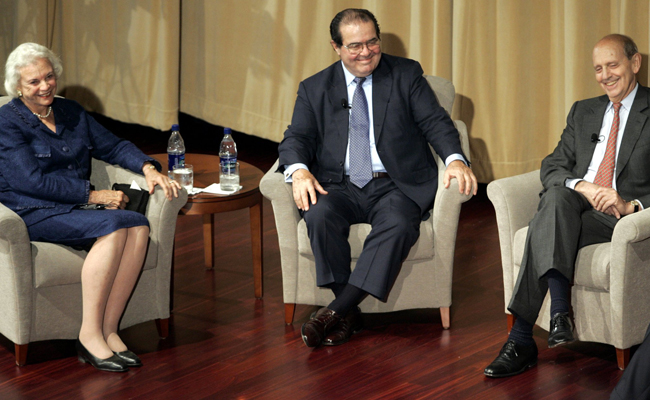Sen. Patrick Leahy has been floating the idea of bringing former Supreme Court justices back to the bench to help decide cases where current justices might have conflicts of interest.
It’s an intriguing concept in the very early idea stages, according Leahy’s aides on the Senate Judiciary Committee. Leahy (D-VT) raised the idea of legislation allowing for the SCOTUS switcharoo first in the National Journal and again in more detail to the Washington Post.
Of course, the former justices in question would be more likely to side with the court’s liberals.
Recusal came up frequently during Elena Kagan’s confirmation hearings to the high court, given her position as solicitor general and the bevy of health care lawsuits percolating in the states. Republicans made this an issue and pushed Kagan frequently on areas where she’d discussed health care reform or immigration with the White House. She says she didn’t, and listed about a dozen cases where she’d sit out if they come before the Supreme Court.
Leahy’s idea — which hasn’t moved beyond the idea phase, as far as we can tell from a series of inquiries today — isn’t likely to be met warmly be Republicans who know very well that the only living former justices are Sandra Day’OConnor, John Paul Stevens and David Souter. They are more likely to side with Kagan than Chief Justice John Roberts. In fact, Leahy told the Post that it was Stevens, in retirement for just a month, who suggested the recusal/fill-in justices idea.
We asked the White House and aides for Judiciary’s ranking member Sen. Jeff Sessions (R-AL) about the Leahy float. The White House did not have an immediate reaction and Sessions is traveling.
The Post reports today:
This would avoid the court potentially splitting 4 to 4 on a case and, Leahy hopes, encourage justices to recuse themselves more often when there is an appearance of partiality.
Leahy told the Post: “I want justices to feel free to recuse themselves when they have a conflict in a specific case.” According to the Post, Leahy is still “smarting” that Justice Antonin Scalia participated in the case related to Vice President Dick Cheney’s secret energy task force, given that they were hunting pals.
“There are now three retired justices who can sit on any federal court, except the court to which they were confirmed,” Leahy told the Post. “If there is a way for retired justices to help the court fulfill its role in our democracy, I think we should consider it. Justice Stevens is absolutely right about this.”
According to the Post, Justice Sonia Sotomayor, a former appeals court judge, has sat out six cases since taking the bench last summer.
Justices recuse themselves occasionally from cases. The choice is theirs and they rarely explain the reason. Most often it is because of a financial conflict or the involvement of a family member. As the court has changed recently — with four new members in five years — the reason for recusal is increasingly because a justice played a role in the case in the lower courts.
The full story is worth a read.









